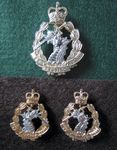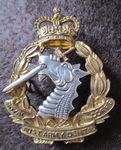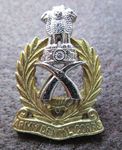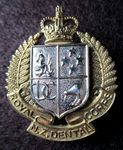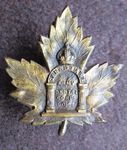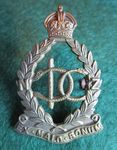Insignia of the Royal Army Dental Corps and Commonwealth Dental Corps
←
→
Page content transcription
If your browser does not render page correctly, please read the page content below
OPEN
GENERAL
Insignia of the Royal Army Dental Corps and
Commonwealth Dental Corps
David R. Radford1
Key points
Illustrates the insignia worn by the Royal Army Recognises that certain Commonwealth Armies Highlights the technical expertise of those
Dental Corps since 1921. had pre-dated the inception date of 1921 in their who manufacture the cap, collar badges and
establishment of separate Dental Corps. sweetheart brooches.
Abstract
The insignia worn by the British and Commonwealth Armed Services are rich in symbolism and meaning to the corps and
regiments that wear them. Originally, before the adoption of national uniforms pre-1700s, there was little to distinguish
friend from foe. To overcome that problem, certainly in battle, it was common practice to wear some sort of distinctive
emblem, such as a sprig of a native plant. This then developed, in the reign of Charles II, to the custom of individual
regiments or corps adopting devices and designs of their ‘colours’, through to modern cap and collar badges.
On the centenary of the Royal Army Dental Corps, this paper gives some insight into those designs adopted by the
Royal and Commonwealth Dental Corps, when a distinct service of dental care was recognised. They give a fascinating
insight into the adoption and amalgamation of both national and dental symbols. The Dental Corps, separate from
Army Medical Corps, went on to develop the vital provision of dental healthcare, both in the field and at home.
Introduction Laines going through boxes of buttons and
cards of cap and collar badges. This paper
Inspired by the British Dental Journal’s is not intended as a collector’s guide but to
edition focusing on the Royal Army Dental give an insight into the variety of designs
Corps and its work and history during the adopted and the skill of metal working
centenary year, 1 I thought it might be of craftsman who produced the cap and collar
interest to write a short article on the insignia badges. When I inherited the collection of
of the corps with some additional notes on predominantly collar badges from my father
Commonwealth Dental Corps insignia. at the turn of the century, I judiciously added
My father inherited a small collection of to it to ensure that it is a ‘living collection’,
military cap badges from his father, who while being mindful that the cost of badges
had served in World War 1. At that time has increased many-fold. I continue to
and until the 1980s, collecting cap and collar cultivate a small specialist collection of UK
badges was a common pastime, with some and Commonwealth Dental Corps insignia,
quite magnificent badges to be found in some of which are illustrated and described
flea markets across the country, sometimes in this paper.
at the cost of only a few pounds. My father
and I used to spend many a happy hour on The Army Dental Corps and Royal Fig. 1 AD Corps officer’s cap and collar
a Saturday afternoon in Brighton’s North Army Dental Corps 1921 to date badges, cast gilt examples (1921–1946). The
intertwined letters ADC in a gothic style
1
Principal Lecturer, University of Portsmouth Dental The British Army Dental Corps (AD Corps) font surrounded by a laurel leaf wreath,
Academy, University of Portsmouth, Hampshire Terrace, surmounted with a king’s crown. The king’s
Portsmouth, PO1 2QG, UK.
was established in 1921 2 to maintain the
Correspondence to: David R. Radford fighting power of the frontline troops by crown (1901–1952, the Tudor crown) was
Email address: david.radford@kcl.ac.uk
reducing wastage caused by debilitating used post the reign of Queen Victoria, before
the use of the present queen’s crown in 1952
Refereed Paper. dental diseases. In those days, corps’ badges
Accepted 10 August 2021
(crown of Saint Edward) in the current reign
often simply consisted of interwoven initials of Queen Elizabeth II
https://doi.org/10.1038/s41415-022-3995-2
of the corps, such as AD Corps, until 1946
BRITISH DENTAL JOURNAL | VOLUME 232 NO. 5 | March 11 2022 339
© The Author(s) under exclusive licence to the British Dental Association 2021.GENERAL
Fig. 2 Officer’s cap and collar badges in two- Fig. 3 Anodised aluminium (staybright)
part silver and gilt metals (RADC 1946–1952). cap and collar badges of the RADC. The cap
The in-facing dragons on the collar badges Fig. 4 Dental Hygienist RADC qualification
badge is shown on a green background.
reflect the craftsmanship of the skilled badge (circa 1970)
Officers’ and soldiers’ caps have a broad
technicians of the manufacturer, J. R. Gaunt green band above the peak (as seen in
of London Figure 3 of ‘The Royal Army Dental Corps
today’8). Anodised aluminium was introduced
into general service wear in the early 1950s
(Fig. 1). This was similar, for example, to
the Army Veterinary Corp (1903–1918) or
the Army Pay Corps (1902–1920). However, Dental Hygienist qualification
in 1946, King George VI granted a Royal badge
prerogative to the AD Corps, thus becoming
the Royal Army Dental Corps (RADC). It Military-trained dental hygienists also received
adopted a much more imaginative design a badge on qualification (Fig. 4). While
for its cap and collar badges, perhaps one lacking the intricacy of previous examples,
of the British Army’s most interesting and it shows crossed swords and a queen’s crown
distinctive (Fig. 2). The design depicts the surmounted by a lion, the insignia of the
legend of Cadmus. According to Greek British Army. The Tri-Service Dental Hygienist
mythology, Cadmus found a dragon had Training School closed in 2013.
killed his soldiers so he slayed the dragon
with one blow of his sword. He heard a Sweetheart brooches
voice instructing him to extract the dragon’s
teeth and sow them in the ground. Cadmus Sweetheart brooches have been in existence Fig. 5 Two examples of sweetheart brooches.
immediately obeyed. As soon as the teeth for over 150 years, with design fashions The top image, a less expensive example of
were planted, a crop of men sprang from the ebbing and flowing. 4 These ornate, a sterling silver bar brooch of the AD Corps
(circa 1939). The lower image is of a more
soil, fully grown and armed. It is from this miniaturised copies of regimental badges
expensive silver and enamel RADC with paste
legend that the RADC takes its motto, ‘Ex were bought by husbands and sons, whatever
diamonds – note the ruby eye of the dragon
Dentibus Ensis’ (from the teeth, a sword).3 In their rank and were given to mothers, wives (1948–1952)
Figure 2, both the cap badge and a pair of and girlfriends; thus, the name ‘sweetheart’
officers’ facing collar badges are shown. The brooches. The cost of these to the individual
collar badges are mirror facing, as one could varied widely due the materials used (such and platinum, inset with rose diamonds, in
not have one dragon facing backwards (in as 18 carat or 9 carat gold, silver, base metal, the region of £25. Those badges purchased
retreat). For the prosthodontists, just think tortoise shell, mother of pearl, enamels, now by collectors, dependant on their rarity
of the technical expertise and skill required paste diamonds and real diamonds) and the and the interest in the particular regiment or
to produce mirror facing dies. With officers’ quality of finish and size of production. For corps, would be between £15–30 or £60–90,
badges finished in silver plate and gilt, they example, in 1939, good-quality silver and respectively and if one could find a diamond
verge on true items of bespoke jewellery. The enamel brooches were retailed at 6 shillings and platinum example in pristine condition,
badge is still in current use with a queen’s and 6 pence (33 pence), solid 9 carat gold at it could have a value of thousands of pounds
crown (Fig. 3). £2 and 10 shillings (£2.50) and 18 carat gold (Fig. 5).
340 BRITISH DENTAL JOURNAL | VOLUME 232 NO. 5 | March 11 2022
© The Author(s) under exclusive licence to the British Dental Association 2021.GENERAL
Fig. 6 Officer’s bronze cap badge of the
Fig. 7 Royal Australian Dental Corps, silver Fig. 9 Cap badge of the Royal New Zealand
Canadian Army Dental Corps (1915–1928).
gilt officer’s cap badge with a queen’s crown Dental Corps in bimetal (1952, queen’s
The Canadian maple leaf was a common
(post-1952), adopting a similar design of the crown). The shield in the centre of the badge
design of the Canadian Expeditionary Forces
British RADC but the scroll superimposed on has four elements: top left, an image of
during and after the First World War. The arch
the wreath is ‘Royal Aust. Army Dental Corps’ Saint Apollonius; top right, the stars of the
depicted in the centre of the badge was taken
rather than a motto Southern Cross constellation; bottom left,
from the Sublime Degree of the Holy Royal
the original insignia of the Corps from 1915;
Arch Masons and is symbolic of the mouth,
and bottom right, the national bird of New
the ‘chief entrance’ to the human body
Zealand, the kiwi. Note that the encircling
wreath changed to the New Zealand fern
rather than the laurel leaf wreath, common
Commonwealth insignia on British Army insignia and the insignia on
the original badge (see Figure 8)
Canadian Army Dental Corps
The Canadian Army Dental Corps was
established in 1915 and received a Royal
designation granted by Royal prerogative in
1947.5 The striking maple leaf design adopted
by the Corps at the time of the First World
War is illustrated in Figure 6. The ensuing
history of the Corps is complex; however, this
is recorded in the ‘History and heritage of the
Royal Canadian Dental Corps’, published in its
centenary year 20155 and the comprehensive
detail is outside the scope of this paper.
Australian Dental Corps Fig. 8 The New Zealand Dental Corps
The Australian Dental Corps was established in 1915–1947. Note the two serpents with the
staff making the initials of ‘DC’ but also the
1943 and received a Royal designation in 1948.
technical expertise of the voided centre of
There is a detailed and well-referenced account
the badge
of dentistry online on the Australian Armed
Services of the twentieth century 6 (Fig. 7).
Fig. 10 A cast Indian Army cap badge post-
one side, thus spelling ‘DC’ for ‘Dental Corps’.
1950. The insignia above the elephant tusks
New Zealand Dental Corps The letters N and Z are super-imposed on the is the ‘Lion Capital’, originally from the time
Similar to the Canadian Army Dental Corps, laurel wreath at the 9 and 3 o’clock positions. of Emperor Ashoka the Great who ruled India
the New Zealand Dental Corps was raised in The motto ‘Ex Malo Bonum’ is translated as (250 BCE), who is credited with the first written
1915 and was granted a Royal designation ‘out of bad comes good’. legislation. Ashoka was the first emperor who
in 1947. The insignia adopted in 1915 is an In 1947, the insignia changed to a much expanded his kingdom across India and erected
unassuming badge but when studied in greater bolder design with imposing cap and collar pillars called the Ashoka stambh or Ashoka
pillars. On top of this pillar sat four lions facing
detail, a fascinating one (Fig. 8). In the centre of badges. The design shows the ingenuity of the
four directions. It was adopted as the official
the laurel wreath are two intertwined serpents, designer, combining the previous design with emblem of India in 19509
with a staff (the rod of Asclepius) placed to national and dental symbols (Fig. 9).
BRITISH DENTAL JOURNAL | VOLUME 232 NO. 5 | March 11 2022 341
© The Author(s) under exclusive licence to the British Dental Association 2021.GENERAL
Indian Army Dental Corps Conclusion References
Like the history of the Canadian Dental Corps, 1. Anderson Q. Military dentistry themed issue. Br Dent
J 2021; DOI: 10.1038/s41415-021-2843-0.
that of the Indian Dental Corps is complex.7 This paper provides some insights into
2. Anderson Q. Dentistry and the British Army: 1661 to
Briefly, initially dental care for Indian officers the fascinating insignia of the British and 1921. Br Dent J 2021; 230: 407–416.
was provided by the British AD Corps. In 1941, Commonwealth Army Dental Corps. The 3. National Army Museum. Officer’s cap badge,
Royal Army Dental Crops, 1965 (c). 2022.
a few civilian dentists were given emergency RADC has a rich history and interrelationship Available at https://collection.nam.ac.uk/detail.
commissions and the Dental Branch of the with its equivalent corps in the Commonwealth. php?acc=1985-06-121-3 (accessed May 2021).
4. Caunt P M. Military Sweetheart Jewellery. 2nd ed.
Indian Medical Service was established. In Insignia worn over the last 100 years, of the London: ARBRAS, 1999.
1943, the Indian Army Dental Corps was different countries’ dental personnel, cleverly 5. Royal Canadian Dental Corps. The History and
Heritage of the Royal Canadian Dental Corps:
established, but in 1945 was merged back combines national and dental devices and A Century of Military Dental Service. 2015.
into the Indian Medical Corps. Subsequent provides attractive cap, collar and sweetheart Available at http://rcdca.cfdental.ca/wp-content/
uploads/2015/05/HistoryandHeritageofthe-RCDC.
to independence in 1947, the Corps was badges. These were for members of the corps pdf (accessed May 2021).
re-established as the Army Dental Corps and for family left behind by military posting, 6. Wikipedia. Royal Australian Army Dental Corps.
2021. Available at https://en.wikipedia.org/wiki/
with the current cap badge adopted in 1950 but now also for collectors. Royal_Australian_Army_Dental_Corps (accessed
(Fig. 10). May 2021).
7. Kochhar P C. History of the Army Dental Corps and
Ethics declaration military dentistry. New Delhi: Lancer, 2000.
The author declares no conflicts of interest. 8. Gibbs N, Porter K. The Royal Army Dental Corps
today. Br Dent J 2021; 230: 447–450.
9. Wikipedia. Lion Capital of Ashoka. 2022.Available
Acknowledgements at https://en.wikipedia.org/wiki/Lion_Capital_of_
Ashoka (accessed May 2021).
I would like to thank Drs Paul Hellyer and Latha
Davda for their critical review of the manuscript.
Open Access.
This article is licensed under a Creative Commons Attribution 4.0 International License, which permits use, sharing, adaptation, distribution and reproduction in any medium or
format, as long as you give appropriate credit to the original author(s) and the source, provide a link to the Creative Commons licence, and indicate if changes were made. The images
or other third party material in this article are included in the article’s Creative Commons licence, unless indicated otherwise in a credit line to the material. If material is not included in
the article’s Creative Commons licence and your intended use is not permitted by statutory regulation or exceeds the permitted use, you will need to obtain permission directly from
the copyright holder. To view a copy of this licence, visit http://creativecommons.org/licenses/by/4.0.
© The Author(s) 2022
342 BRITISH DENTAL JOURNAL | VOLUME 232 NO. 5 | March 11 2022
© The Author(s) under exclusive licence to the British Dental Association 2021.You can also read




